
Original Link: https://www.anandtech.com/show/1431
Intel 925X Roundup: Creative Engineering 101
by Wesley Fink on August 12, 2004 12:05 AM EST- Posted in
- Motherboards
Intel launched the new Socket 775 processors and the 925X/915 chipsets to support them on June 19th. Since that time, motherboards based on the top 925X chipset have been hard to find, with very few offerings to choose from in the market. This was further compounded by the recall of some defective ICH6 chips shortly after the launch of the new chipsets.
Now, almost 2 months after launch, we have 5 new motherboards based on the latest 925X chipset. A quick check at online retailers found that 4 of the 5 new motherboards were now available. The only exception was the just-launched DFI LANParty 925X-T2.
As we discussed in the 925X/915 chipset launch, almost everything about the 925X and 915 are new. This extends from the new Socket T (775), to DDR2 memory, to the new PCI Express bus, to new PCIe video cards, to new Heatsinks, and so on. It's been a long time since so much is new, and you can read more about the new features in:
Intel's 925X & LGA-775: Are Prescott 3.6 and PCI Express Graphics any Faster?
Intel 925X/915: Chipset Performance & DDR2
The five motherboards in this roundup represent an interesting mix, with four manufacturers that you would expect to see producing a top-of-the-line 925X motherboard - Abit, Asus, DFI, and Gigabyte - and one company that may surprise you. Foxconn is a new name for many AnandTech readers, but they are a very large manufacturer in Taiwan, producing many motherboards for other manufacturers. Foxconn has been producing motherboards under their own brand recently, and we reviewed an entry-level Foxconn 755 board a few months ago. However, the 925X is the top of Intel's desktop line, and this is the first high-end Foxconn board that we have reviewed.
We have already done some testing of the Asus P5AD2 and Abit AA8 as we explored the Intel Overclock lock in the last few weeks. You can find more information on that concern and the response of manufacturers to this issue in:
Breaking Intel's Overclock Lock: The REAL Story
Intel 925X: Exploring the Overclock Lock
Information on each board's overclocking performance is included in the Overclocking and Stress Testing page for each board.
The 925X is Intel's premium chipset, and you will see that reflected in the motherboards in this roundup. These five motherboards represent a price range from $161 to $277, certainly a premium price range in today's market. As we run each of the 925X boards through our benchmark suite and stress testing, we will be determining which boards stand out from the crowd in either performance or features. Are these new 925X boards worth the expensive price tags that we find on these latest Intel creations?
Abit AA8: Features and Layout
| Abit AA8 Motherboard Specifications | |
| CPU Interface | Socket 775 Pentium 4 (Prescott) |
| Chipset | Intel 925X/ICH6R |
| Bus Speeds | 200MHz to 336MHz (in 1MHz increments) |
| DDR2 Speeds | Auto, 400, 533 |
| PCI Speeds | 33.33, 36.36, 40.00 |
| Core Voltage | 1.4375V to 1.7875V in 0.0125V increments |
| DRAM Voltage | 1.80V to 2.25V in 0.05V increments |
| NB (Northbridge) Voltage | 1.50V-2.05V in 0.05V increments |
| Memory Slots | Four 240-pin DDR2 533 Slots Dual-Channel Unbuffered Memory to 4GB |
| Expansion Slots | 1 PCIe x16 Slot 3 PCIe x1 slot 2 PCI Slots |
| Onboard SATA/IDE RAID | 4 SATA 150 drives by ICH6R Can be combined in RAID 0, 1, Intel Matrix |
| Onboard IDE | One Standard ATA100/66 (2 drives) |
| Onboard USB 2.0/IEEE-1394 | 8 USB 2.0 ports 3 IEEE 1394 FireWire Ports by TI 4200R7T |
| Onboard LAN | Gigabit Ethernet by Realtek 8110S-32 |
| Onboard Audio | Realtek ALC880 (HD Audio) 8-Channel with SPDIF in/out |
| Tested BIOS | 1.3 |
The AA8 DuraMAX is Abit's flagship board for the Pentium 4 LGA 775. This is reflected in the feature set, but the AA8 was also designed to sell at a rational price point compared to other 925X boards. Abit does include 3 Firewire ports for those who need firewire connections, but the feature set is otherwise straight Intel 925X. There is nothing wrong with this approach as the 925X/ICH6R includes 8 USB 2.0 ports, PCI Express, 4-port SATA RAID with Intel Matrix options, and support for Intel High Definition (Azalia) audio.
Abit has included their typical wide selection of voltages and frequencies to get the most from the AA8 and the Pentium 4 Prescott. Abit was also one of the first motherboard makers to significantly break through the overclocking limitations of the 925X chipset. So, there are some additional automatic manipulations being made by µGuru at boot, where the PCIe frequency is adjusted dynamically in relation to the CPU frequency prior to boot. The overclocking controls are typically Abit, but perhaps the range is a little more limited than we see on other Abit boards. Abit decided not to include PCI Express speed adjustments in the BIOS - they are being manipulated in µGuru instead.
The voltage adjustments that are included in the BIOS have a wider range than you will see on most 925X boards, which will please overclockers who intend to use water or phase-change cooling on the AA8. The important Northbridge adjustments extend from the default 1.5V all the way to 2.05V, which is a wider range than you find on any other board. Abit has added a pretty hefty heatsink with a side-blowing fan to the northbridge to handle the voltage range that they have built into the AA8.
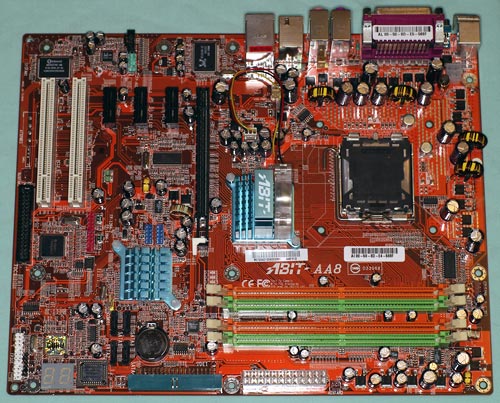
Abit uses a flat edge connector for the single IDE connection provided by the 925X chipset. In most mid-tower cases, we suggest that you connect the IDE cable before you mount the board, since the connector falls under the hard drives in many case designs and is difficult to reach after the board is screwed down. We like the idea of edge connectors, but some case designs make it very difficult to connect the edge-connectors. The floppy connector will not matter to some, but if you use a floppy, you will find the location a real problem, at the very bottom center of the motherboard. When you try to route the floppy cable to clear the 4 SATA connectors, it tends to hide the diagnostic LEDs and interfere with the front-panel connectors. The bulky 24-pin power connector is on the right board edge and 4-pin 12V connector are on the top board edge. Both these locations are excellent in that they will not force you to fish cables over or around the CPU. The Abit trademark 2-digit diagnostic LEDs are also found on the AA8, and we have found that they can be very useful for troubleshooting.
Abit uses the Realtek ALC880 codec with the Intel HD audio on the AA8. This is the same High-Definition audio codec that we see used in most motherboards in the roundup. Realtek says that their 7.1 Channel High Definition Audio features four 24-bit two-channel DACs and three stereo 20-bit ADCs. "The ALC880(D) also achieves 100dB sound quality; easily meeting PC2001 requirements and also bringing PC sound quality closer to consumer electronic devices." You can find more information on the features and specifications of the Realtek 880 at the Realtek website.
Abit AA8: Overclocking and Stress Testing
FSB Overclocking Results
| Front Side Bus Overclocking Testbed | ||
| Processor: | Pentium 4 Prescott LGA 775 2.8GHz |
|
| CPU Voltage: | 1.3875V (default) | |
| Cooling: | Thermaltake Jungle 502 | |
| Power Supply: | HiPro 470W | |
| Maximum OC: | 260FSB (+30%) | |
Like the earlier Socket 478 Pentium 4 processors, the LGA 775 CPUs are multiplier locked. Therefore, the only way to overclock the CPU is to increase the FSB. Unfortunately, the PCI Express bus is not locked, or rather, fixing the frequency tends to limit the overclocking of the 925X. Abit manipulates the PCIe frequency with µGuru during boot to achieve higher overclocks. For more information on how Abit manages to overclock the AA8, please check Breaking Intel's Overclock Lock: The REAL Story.
The AA8 was able to achieve a reach for FSB of 260, a 30% overclock, with an ATI X800 XT and SATA hard drive. Abit was able to achieve close to the same overclock with the nVidia 6800 Ultra at 258. The nVidia is generally less tolerant of out-of-spec PCIe frequency, so this performance is really excellent.
Memory Stress Test Results:
The memory stress test measures the ability of the Abit AA8 to operate at its officially supported memory frequency (533MHz DDR2), at the best performing memory timings that Crucial/Micron PC2-4300U will support. Memory stress testing was conducted by running DDR2 at 533MHz (stock 3:4 ratio) with 2 DIMM slots operating in Dual-Channel mode.| Stable DDR533 Timings - 2 DIMMs (2/4 DIMMs - 1 Dual-Channel Bank) |
|
| Clock Speed: | 266MHz |
| Timing Mode: | 3:4 (200:266 - Default) |
| CAS Latency: | 3.0 |
| Bank Interleave: | Auto |
| RAS to CAS Delay: | 3 |
| RAS Precharge: | 3 |
| Cycle Time (tRAS): | 10* |
| Command Rate: | N/A |
The Abit AA8 DuraMAX was completely stable with 2 DIMMs in Dual-Channel at the DDR2 settings of 3-3-3-10 at 1.8V default voltage. These are much faster settings than the DDR2 SPD and rated timings of 4-4-4-12.
Filling all four available memory slots is more strenuous on the memory sub-system than testing 2 DDR2 modules on a motherboard.
| Stable DDR533 Timings - 4 DIMMs (4/4 DIMMs - 2 Dual-Channel Banks) |
|
| Clock Speed: | 266MHz |
| Timing Mode: | 3:4 (200:266 - Default) |
| CAS Latency: | 4.0 |
| Bank Interleave: | Auto |
| RAS to CAS Delay: | 3 |
| RAS Precharge: | 3 |
| Cycle Time (tRAS): | 10 |
| Command Rate: | N/A |
DDR has a long benchmarking history that makes it easier to figure out where to go with memory timings. We are still in the learning curve with DDR2, and the old DDR patterns just do not work in DDR2. We found that no matter what the rest of the settings, 4 DIMMs with DDR2 required CAS 4 for stability. Timings like 3-4-3 or 3-4-4 appeared to work fine, and then we were suddenly facing hard drive corruption. Our advice for now is to use CAS 4 with 4 DIMMs for stability, although 4-3-3 timings did work fine on many of the test boards. If you plan to try raising voltage to attempt lower CAS with 4 DIMMs, then please backup your system first. Our test beds gave no warning at all before hard drive corruption with overly aggressive timings using 4 DIMMs.
Asus P5AD2 Premium: Features and Layout
| Asus P5AD2 Premium Motherboard Specifications | |
| CPU Interface | Socket 775 Pentium 4 (Prescott) |
| Chipset | Intel 925X/ICH6R |
| Bus Speeds | 100MHz to 400MHz (in 1MHz increments) |
| PCI Speeds | To CPU, 33.33, Auto |
| DDR2 Speeds | Auto, 400, 533, 600 |
| Core Voltage | 1.4375V to 1.7875V in 0.0125V increments |
| DRAM Voltage | 1.80V to 2.10V in 0.1V increments |
| Chipset Voltage | Auto, 1.5V, 1.6V |
| FSB Termination Voltage | Auto, 1.2, 1.4 |
| Memory Slots | Four 240-pin DDR2 Slots Dual-Channel Unbuffered Memory to 4GB |
| Expansion Slots | 1 PCIe x16 Slot 2 PCIe x1 slot 3 PCI Slots |
| Onboard SATA/IDE RAID | 4 SATA 150 drives by ICH6R Can be combined in RAID 0, 1, Intel Matrix plus 4 SATA 150 RAID by Sil3114R (8 Total SATA ports) |
| Onboard IDE | One Standard ATA100/66 by ICH6R (2 100/66/33 drives) Plus One IDE RAID by IT 8212F (2 133/100/66, RAID 0, 1, JBOD) |
| Onboard USB 2.0/IEEE-1394 | 8 USB 2.0 ports 3 IEEE 1394b FireWire Ports by TI 1394b |
| Onboard LAN | 2 X Gigabit PCIe LAN Both by Marvel 88E8053 |
| Onboard Audio | CMedia CMI9880 (Intel HD) 8-Channel with SPDIF in/out |
| Wireless LAN | WiFi 802.11g Included |
| Tested BIOS | 1005 Beta 002 |
Asus calls their new 925X board the P5AD2 Premium, and the board is clearly top-of-the-line in every way. All of the Asus Proactive AI (Artificial Intelligence) features are included, and Asus proudly advertises the overclocking features of the P5AD2 Premium. This includes a special cooling plate on the bottom of the board in the CPU area that Asus calls Stack Cool.
Asus includes Dual Gigabit PCI Express LAN on the P5AD2, with both LAN ports powered by the new Marvel 88E8053 Ethernet controllers. You will also find a complete WiFi set-up with an 802.11g card and antenna included for the WiFi slot. Asus has devoted a lot of resources recently to providing standard-setting Wireless LAN on their motherboards, and the P5AD2 is the culmination of those efforts.
You will also find the premium C-Media CMI9880 codec supporting the Intel High-Definition audio, with 8 channels and Dolby Digital Live technology support. The CMI9880 is the only audio solution in this roundup that has a built-in Dolby AC3 encoder that can actually encode your digital audio into Dolby digital streams, which can then be output to the SPDIF for Dolby Digital playback. The CMI9880 does this real-time for any digital audio in your system to feed Dolby Digital playback. The rest of the boards in the roundup use sound solutions based on the newest Realtek ALC880 High-Definition audio chip, which is also an excellent audio solution, but Asus carries Intel High-Definition (Azalia) audio further on the P5AD2 than on any other board in this roundup. You will also find 3 of the high-speed 'b' versions of IEEE 1394 firewire, which promise double the speed of 1394a ports.
The storage area is one area where the Asus stands above the rest of the boards reviewed here. All of the boards support the ICH6R standard 4 SATA/1 IDE (2drives) configuration. The Asus and Gigabyte add 4 more SATA ports for a total of 8 SATA ports. The Asus goes even further by also adding an ITE controller for 2 more IDE devices for a total of 4.
It is clear that Premium certainly describes the features on the Asus P5AD2, but Premium also refers to the price. The Premium is the most expensive board in this roundup at about $100 more than the Abit AA8. The real question, then, is whether the Asus is worth the premium price. That is a question that you will need to answer based on your individual budget, but there is no other board in this roundup that offers the unique and useful feature set that you will find on the P5AD2.
Asus has also provided a truly complete set of overclocking controls in the BIOS. It is worth noting that the P5AD2 is the only board in the roundup to offer a DDR600 memory speed in addition to the 533 and 400 offered on all the boards. Since we found that the current DDR2 memory was all capable of DDR667 performance, this added 2:3 ratio will allow for running DDR2 at 667 with just a modest CPU overclock, something that will appeal to some users. Asus also provides adjustment of FSB termination voltage, something that we found useful in the extreme overclocking possible on the Asus.

Asus is a manufacturer who pays close attention to the layout of their motherboards. That certainly shows in the P5AD2 Premium. Floppy and Hard Drive connectors are in the preferred upper right board-edge position, where they usually work best in most case designs. The 24-pin power connector and 4-2pin 12V connector are both at board edges where they do not require being snaked across the CPU and restricting air flow. The 8 SATA ports are clustered at the lower right of the board (4 ports) and the bottom edge of the board (4 ports). The additional IDE connector is also near the bottom edge along with the headers for additional SATA and IEEE1384b ports.
The only complaint with the layout will be from those who still use a 4-pin audio header to one of their optical drives, since the audio connector is in the worst possible location at the bottom left of the motherboard. In a tower case, you will need to search for a longer audio cable, not an easy-to-find item, since every audio cable we had on-hand would not reach from the drive to the audio connector in a tower case. This should not be an issue in the more common mid-tower layouts.
The P5AD2 layout is very close to ideal and you will likely be very pleased at the thought that went into the layout of the Asus 925X.
Asus P5AD2 Premium: Overclocking and Stress Testing
FSB Overclocking Results
| Front Side Bus Overclocking Testbed | ||
| Processor: | Pentium 4 Prescott LGA 775 2.8GHz |
|
| CPU Voltage: | 1.3875V (default) | |
| Cooling: | Thermaltake Jungle 502 | |
| Power Supply: | HiPro 470W | |
| Maximum OC: | 280FSB (+40%) | |
The LGA 775 CPUs are multiplier locked, so the only way to overclock the CPU is to increase the FSB. Fixing the PCIe frequency tends to limit the overclocking of the 925X, so Asus, like others in the roundup, allows the PCI Express frequency to float. Asus then manipulates the PCIe frequency (or ratios to be more precise) during boot to achieve higher overclocks. For more information on how Asus manages to reach such outstanding overclock with the P5AD2, please check Breaking Intel's Overclock Lock: The REAL Story.
The Asus was able to reach a FSB of 280, a 40% overclock, with an ATI X800 XT and SATA hard drive. This is by far the highest overclock that we achieved with this hardware in the roundup. The P5AD2 was more limited with an nVidia 6800 Ultra video card, reaching 258. The nVidia appears to be less tolerant of out-of-spec PCIe frequency than the X800 XT.
Memory Stress Test Results:
The memory stress test measures the ability of the Asus P5AD2 to operate at its officially supported memory frequency (533MHz DDR2), at the best performing memory timings that Crucial/Micron PC2-4300U will support. Memory stress testing was conducted by running DDR2 at 533MHz (stock 3:4 ratio) with 2 DIMM slots operating in Dual-Channel mode.| Stable DDR533 Timings - 2 DIMMs (2/4 DIMMs - 1 Dual-Channel Bank) |
|
| Clock Speed: | 266MHz |
| Timing Mode: | 3:4 (200:266 - Default) |
| CAS Latency: | 3.0 |
| Bank Interleave: | Auto |
| RAS to CAS Delay: | 3 |
| RAS Precharge: | 3 |
| Cycle Time (tRAS): | 10* |
| Command Rate: | N/A |
The Asus P5AD2 Premium was completely stable with 2 DDR2 modules in Dual-Channel at the settings of 3-3-3-10 at 1.8V default voltage. This matches the best timings that all the motherboards in this roundup were able to achieve with DDR2 memory. 3-3-3 is also faster than the specified 4-4-4 timings specified for the Crucial/Micron DDR2 modules used for these benchmarks.
Filling all four available memory slots is more strenuous on the memory sub-system than testing 2 DDR2 modules on a motherboard.
| Stable DDR533 Timings - 4 DIMMs (4/4 DIMMs - 2 Dual-Channel Banks) |
|
| Clock Speed: | 266MHz |
| Timing Mode: | N/A |
| CAS Latency: | 4.0 |
| Bank Interleave: | N/A |
| RAS to CAS Delay: | 3 |
| RAS Precharge: | 10T* |
| Precharge Delay: | 3.0 |
| Command Rate: | N/A |
As we first saw on the Abit, 4 DDR2 DIMMs are not stable at CAS 3 as 2 DIMMs are. Once again, we required 4-3-3 timings when using 4 DDR2 DIMMs, though 4-3-3 worked fine at default voltage. Perhaps more voltage could improve stability at 3-3-3 with 4 DIMMs, but our tests up to 2.0V (from default 1.8V) did not produce enough stability to complete our Super Pi or Aquamark 3 at the 3-3-3 timings.
DFI LANParty 925X-T2: Features and Layout
| DFI LANParty 925X-T2 Motherboard Specifications | |
| CPU Interface | Socket 775 Pentium 4 (Prescott) |
| Chipset | Intel 925X/ICH6R |
| Bus Speeds | 200MHz to 300MHz (in 1MHz increments) |
| PCI Speeds | To CPU, 33.33, Auto |
| PCI Express Speeds | Auto, Fix 100-140 |
| DDR2 Speeds | Auto, 400, 533 |
| Core Voltage | 0.8375V to 1.85V |
| DRAM Voltage | 1.8V to 2.5V in 0.1V increments |
| Northbridge Voltage | 1.5V to 1.8V in 0.1V increments |
| Memory Slots | Four 240-pin DDR2 Slots Dual-Channel Unbuffered Memory to 4GB |
| Expansion Slots | 1 PCIe x16 Slot 3 PCIe x1 slot 3 PCI Slots |
| Onboard SATA/IDE RAID | 4 SATA 150 drives by ICH6R Can be combined in RAID 0, 1, Intel Matrix |
| Onboard IDE | One Standard ATA100/66 (2 drives) |
| Onboard USB 2.0/IEEE-1394 | 8 USB 2.0 ports 2 IEEE 1394 FireWire Ports by VIA VT6307 |
| Onboard LAN | 2 Gigabit LAN - Marvel 88E8053 PCIe and Marvel 88E8001 PCI |
| Onboard Audio | Karajan Module with Realtek ALC880 Codec with Independent Variable Sampling 8-Channel with SPDIF in/out |
| Tested BIOS | 925LC803 |
When DFI first introduced the LANParty boards a little over a year ago, they were not a name with which many Enthusiasts were familiar. However, since that time, DFI has earned a solid reputation as a maker of some of the best-performing and most sought-after boards available in the Enthusiast market. The 925X-T2 is DFI's second design for the Intel socket, following the highly regarded LANParty boards for socket 478.
The LANParty 925X-T2 keeps all the bells and whistles that made the original LANParty series so unique. This includes UV slots and ports, matching UV sensitive round cables, a flexible FrontX port box that will fit in a 5-1/4 bay and organize your ports, and the completely unique PC Transpo for carrying your desktop system to LAN parties.
There are also a couple of new additions to generation 3 of LANParty. DFI included coordinated UV sleeving for the other cables in your rig, and High-Definition audio is provided by a plug-in Karajan module. DFI tells us that the plug-in audio module allows the electrical isolation of the audio codec, resulting in a lower noise than you might experience with an on-board audio codec.
The rest of the features are a complete implementation of the 925X/ICH6R chipset, with the added benefit of two Gigabit LAN controllers. One LAN controller sits on the faster PCI Express bus and the other is on the PCI bus.
In overclocking, the DFI offers the widest range of voltages that you will see on any of the boards in the roundup. It is the only 925X with DDR2 memory voltage adjustments to 2.5V and a CPU voltage adjustment to 1.85V. These values should even put smiles on the faces of users who plan to use water-cooling or phase-change cooling. Northbridge voltage is also adjustable. Instead of making all the PCIe decisions for you, like boards that only offer Auto adjustments, or forcing extensive manual trial and error- like manual only controls, the DFI offers both options. You can let the board make the sliding ratio adjustments for you with Auto, or you can dial your own with manual PCI fix adjustments.
DFI also continues CMOS reloaded, which was introduced with the second generation LANParty and Infinity boards. This feature allows you to save several different custom BIOS set-ups so that you can easily recall custom BIOS settings for a particular overclock or settings for a different OS. Overclockers and users who run multiple operating systems will really find CMOS Reloaded to be a useful feature.
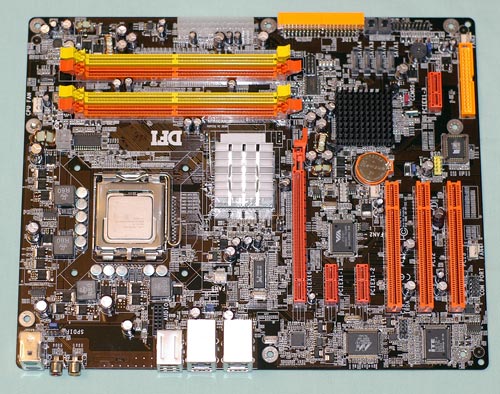
In general, the DFI is well-laid out for most cases, since it is a board that was designed to be seen in a side window case. One of the more annoying things about the layout is the board edge connector for IDE and the bottom edge floppy connector, which are only a little better located than the Abit. However, the diagnostic LEDs on the DFI are better located than the Abit. They are clear of obstructions so you can actually see the LEDs during boot. The 24-pin and 4-pin power connectors are both near board edges to the right of the CPU and are probably the best located of any board in this roundup. You don't even have to snake the 4-pin around the CPU as you do in some other 925X designs in the roundup. The Karajan audio module was a little flimsy in our early board, but DFI told us when we got the board that shipping boards would have a bracket to secure the module. That should take care of that issue.
As we have come to expect with LANParty boards, DFI continues to innovate with their flagship line of boards. The LANParty is clearly aimed at the computer Enthusiast who wants to show off their rig, and it makes no apologies for being brash and showy. No matter how much it glows, the LANParty boards wouldn't sell unless they also delivered top-notch Enthusiast-level performance, and DFI continues to lavish most of their attention on how the LANParty boards actually perform.
DFI LANParty 925X-T2: Overclocking and Stress Testing
FSB Overclocking Results
| Front Side Bus Overclocking Testbed | ||
| Processor: | Pentium 4 Prescott LGA 775 2.8GHz |
|
| CPU Voltage: | 1.3875V (default) | |
| Cooling: | Thermaltake Jungle 502 | |
| Power Supply: | HiPro 470W | |
| Maximum OC: | 265FSB (+33%) | |
Like Asus and Abit, DFI manipulates the PCIe frequency during boot to achieve higher overclocks. The DFI was able to reach a FSB of 265, a 40% overclock, with an ATI X800 XT and SATA hard drive. This is the second highest overclock that we achieved with this hardware in the roundup. The LANParty 925X-T2 was more limited with an nVidia 6800 Ultra video card, reaching 248. As we have already stated, the nVidia PCIe cards are apparently less tolerant of out-of-spec PCIe frequency than the X800 XT.
DFI was able to achieve even higher overclocks with PCIe and SATA drives in their own lab tests, but we are finding that the PCI Express cards do vary a good bit in their ability to handle out-of-spec PCIe speeds. We used the same ATI X800 XT for all overclock tests in this roundup, so results could be compared one board to another.
The LGA 775 CPUs are multiplier locked, so the only way to overclock the CPU is to increase the FSB, but most manufacturers are floating the PCIe to achieve higher overclocks by manipulating CPU clock/PCIe ratios. All of the successful 925X overclockers are saying that fixing the frequency tends to limit the overclocking of the 925X to around 10%.
Memory Stress Test Results:
The memory stress test measures the ability of the DFI 925X-T2 to operate at its officially supported memory frequency (533MHz DDR2), at the best performing memory timings that Crucial/Micron PC2-4300U will support. Memory stress testing was conducted by running DDR2 at 533MHz (stock 3:4 ratio) with 2 DIMM slots operating in Dual-Channel mode.| Stable DDR533 Timings - 2 DIMMs (2/4 DIMMs - 1 Dual-Channel Bank) |
|
| Clock Speed: | 266MHz |
| Timing Mode: | 3:4 (200:266 - Default) |
| CAS Latency: | 3.0 |
| Bank Interleave: | Auto |
| RAS to CAS Delay: | 3 |
| RAS Precharge: | 3 |
| Cycle Time (tRAS): | 10* |
| Command Rate: | N/A |
DFI also performs without issue at the best 3-3-3-10 DDR2 timings that work well on all the 925X boards in the roundup.
Filling all four available memory slots is more strenuous on the memory sub-system than testing 2 DDR2 modules on a motherboard.
| Stable DDR533 Timings - 4 DIMMs (4/4 DIMMs - 2 Dual-Channel Banks) |
|
| Clock Speed: | 266MHz |
| Timing Mode: | 3:4 (200:266 - Default) |
| CAS Latency: | 4.0 |
| Bank Interleave: | Auto |
| RAS to CAS Delay: | 3 |
| RAS Precharge: | 3 |
| Cycle Time (tRAS): | 10 |
| Command Rate: | N/A |
The DFI LANParty 925X-T2 handled 4 DDR2 DIMMs at default voltage, at 4-3-3-10 timings, the same timings required on the Asus and Abit boards. It is very early in our testing of DDR2 memory - too early to draw firm broad conclusions - but it looks as if DDR2 memory may require slower timings with 4 DIMMs than what we can achieve with 2 DIMMs. Since we are accustomed to similar timings with either 2 or 4 DIMMs with regular DDR memory, this is a bit of a disappointment.
Foxconn 925A01: Features and Layout
| Foxconn 925A01 Motherboard Specifications | |
| CPU Interface | Socket 775 Pentium 4 (Prescott) |
| Chipset | Intel 925X/ICH6R |
| Bus Speeds | 200MHz to 350MHz (in 1MHz increments) |
| PCI Speeds | 33.33, 36.36, 40.00, Ref PCIex |
| PCI Express Speeds | 100MHz to 200MHz in 1MHz increments |
| DDR2 Speeds | Auto, 400, 533 |
| Core Voltage | +.0125V to +.1875V in 0.0125V increments |
| DRAM Voltage | +.03V, +.06V, +.10V |
| System Core Voltage | +.03V, +.06V, +.10V |
| Memory Slots | Four 240-pin DDR2 Slots Dual-Channel Unbuffered Memory to 4GB |
| Expansion Slots | 1 PCIe x16 Slot 2 PCIe x1 slot 3 PCI Slots |
| Onboard SATA/IDE RAID | 4 SATA 150 drives by ICH6R Can be combined in RAID 0,1,Intel Matrix |
| Onboard IDE | One Standard ATA100/66 (2 drives) |
| Onboard USB 2.0/IEEE-1394 | 8 USB 2.0 ports 2 IEEE 1394a FireWire Ports by VIA VT6307 |
| Onboard LAN | Gigabit Ethernet by Realtek 8110S-32 |
| Onboard Audio | Realtek ALC880 8-Channel with SPDIF |
| Tested BIOS | 3C1XP216 |
The only Foxconn boards that we have tested so far have been value boards, and Foxconn has earned a reputation of building solid motherboards that represent very good value. The Foxconn 925A01 is a different type of motherboard for Foxconn, since the 925X chipset is Intel's premium chipset no matter how you approach it. This is also reflected in the fact that while almost everyone offers a 915 "mainstream" motherboard, only five manufacturers so far are shipping 925X motherboards.
Foxconn has positioned the 925A01 at the value end of the 925X curve. It costs a little more than the Abit AA8, but it is a lot less expensive than either the Asus P5AD2 Premium or the Gigabyte GA-8ANXP-D. Foxconn did not cut corners, however, as the 925X-A01 fully implements the 925X feature-set all the way down to the Intel HD audio. It appears that Foxconn's fist intent was to produce a board that would compete with the Intel motherboards in the marketplace, since the Foxconn was lacking in almost all the overclocking features that the other boards in this roundup possess. However, Foxconn quickly provided an updated BIOS that significantly improved on the BIOS adjustments available on the Foxconn.
That is not to say that the Foxconn is a board that the enthusiast will seek out. With the latest BIOS, the Foxconn has a very complete selection of CPU voltage adjustments and the CPU clock is adjustable over a very acceptable range from 200 to 350, but the memory voltage adjustments are extremely anemic, topping out at 1.9V from a starting point of 1.8V. The same can be said for the Northbridge voltage adjustments; though, we are pleased to see Foxconn offer this option in the BIOS. Foxconn says that there is an update to the design in process that will improve the range of memory voltage and Northbridge voltage adjustments. Those changes will bring Foxconn much more into line with the other top-of-the-line boards in this roundup.
The feature set of the 925A01 is excellent, and will satisfy most users. Foxconn even included the 6 mini-jacks needed for Intel High Definition audio, and Firewire ports for those who prefer that interface. The only weakness in the audio ports is that only an SPDIF coaxial connector is provided on an accessory bracket. There is no provision at all for an optical connector.
All-in-all, the Foxconn is not quite to the level of the other boards in this roundup, but it is surprisingly close. It also excels in the most important quality of all; it is rock solid no matter what we threw at it. With the coming update, the 925A01 should prove very competitive with the other boards in this roundup.
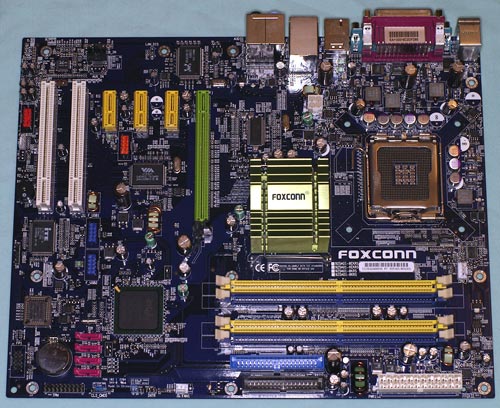
Layout of the Foxconn 925A01 is among the better layouts in the roundup. Both the floppy and IDE connectors are in the preferred upper right edge location where they work best for most cases. The bulky 24-pin connector is at the top right edge, which is probably the best location that you could find on a board. The 24-pin is out of the way of other cables, which is what you want in a good board design. The 4-in 12 volt is near the center of the board on the left side of the CPU, which is not the best location because it requires snaking the cable around the CPU. However, it is easier to fish a 4-in cable than the bulky 24-pin.
There is one other concern in the Foxconn layout. It seems that there is trend to provide just a 2-pin connector for the power LED these days, but many power supplies still are equipped with the 3-pin connector. You can do a little surgery on the connector, since there are just 2 active pins. Other boards provide both 2-pin and 3-pin power LED connectors, but the 925A01 has just the 2-pin connector. For those of you with a 3-pin power LED, your only option on the Foxconn is to modify your cable or leave the power LED not connected.
Nitpicks aside, there really is little to complain about in the Foxconn board layout. We mounted all 5 of the boards in a typical mid-tower case just to see how the layout worked and the Foxconn was an easier layout to work with than either the Abit or the DFI.
Foxconn 925A01: Overclocking and Stress Testing
FSB Overclocking Results
| Front Side Bus Overclocking Testbed | ||
| Processor: | Pentium 4 Prescott LGA 775 2.8GHz |
|
| CPU Voltage: | 1.3875V (default) | |
| Cooling: | Thermaltake Jungle 502 | |
| Power Supply: | HiPro 470W | |
| Maximum OC: | 218FSB (+9%) - 100 PCIe or Auto 248FSB (+24%) - 114 PCIe |
|
The LGA 775 processors are multiplier locked, so the only way to overclock the CPU is to increase the FSB. Most of the manufacturers in this roundup float the PCI Express bus and manipulate ratios to achieve higher overclocks. Foxconn takes a different approach by providing a wide adjustment range of fixed PCIe frequencies only. There is no provision to float the PCIe bus.
We were able to confirm the limitations of this approach by reaching a rather dismal 9% overclock with the PCIe fixed at 100. However, we had learned on the DFI and Abit that the nVidia could tolerate a PCIe frequency of at least 114 with simple algorithms or perhaps as high as 120 with more exotic manipulations. So, we set the PCIe to a fixed 114 and started increasing the CPU Clock. With a 114 PCIe, we reached a 248 overclock or 24%. We could not reach any higher, however, with either the ATI X800 XT or the nVidia. Apparently, there is more to the overclocks that others are achieving than just a tales of forced PCIe:CPU ratios. Considering the simplicity of the Foxconn design, however, this is a really excellent overclock that will satisfy many potential 925X shoppers. Just keep in mind that you really have to play with the very sensitive ratios between CPU and PCIe to achieve this kind of overclock on the Foxconn 925x-A01.
Memory Stress Test Results:
The memory stress test measures the ability of the Foxconn 925A01 to operate at its officially supported memory frequency (533MHz DDR2), at the best performing memory timings that Crucial/Micron PC2-4300U will support. Memory stress testing was conducted by running DDR2 at 533MHz (stock 3:4 ratio) with 2 DIMM slots operating in Dual-Channel mode.| Stable DDR533 Timings - 2 DIMMs (2/4 DIMMs - 1 Dual-Channel Bank) |
|
| Clock Speed: | 266MHz |
| Timing Mode: | 3:4 (200:266 - Default) |
| CAS Latency: | 3.0 |
| Bank Interleave: | Auto |
| RAS to CAS Delay: | 3 |
| RAS Precharge: | 3 |
| Cycle Time (tRAS): | 10* |
| Command Rate: | N/A |
The Foxconn matched the other boards in the 925X roundup in being able to run with complete stability at 3-3-3-10 timings with two DDR2 DIMMs. The 925A01 was completely stable at these timings at the default 1.8V.
Filling all four available memory slots is more strenuous on the memory sub-system than testing 2 DDR2 modules on a motherboard.
| Stable DDR533 Timings - 4 DIMMs (4/4 DIMMs - 2 Dual-Channel Banks) |
|
| Clock Speed: | 266MHz |
| Timing Mode: | 3:4 (200:266 - Default) |
| CAS Latency: | 4.0 |
| Bank Interleave: | Auto |
| RAS to CAS Delay: | 4 |
| RAS Precharge: | 3 |
| Cycle Time (tRAS): | 10 |
| Command Rate: | N/A |
When all 4 DDR2 slots are filled, the Foxconn required slightly slower timings than the top boards in the roundup, requiring 4-4-3 timings for complete stability instead of the 4-3-3, which worked well on the Abit, Asus and DFI boards. This is only very slightly slower than the timings on the top 3 boards, and could just as well represent variations in board samples as much as any differences in memory performance with 4 DIMMs.
Gigabyte 8ANXP-D: Features and Layout
| Gigabyte 8ANXP-D Motherboard Specifications | |
| CPU Interface | Socket 775 Pentium 4 (Prescott) |
| Chipset | Intel 925X/ICH6R |
| Bus Speeds | 100MHz to 355MHz (in 1MHz increments) |
| PCI Speeds | To CPU, 33.33, Auto |
| DDR2 Speeds | Auto, 2.0, 2.66 |
| Core Voltage | 0.8375 to 1.60V in 0.0125V increments |
| DRAM Voltage | Auto, +.1, +.2, +.3 |
| PCI Express Voltage | Auto, +.1, +.2, +.3 |
| Memory Slots | Six 240-pin DDR2 Slots Dual-Channel Unbuffered Memory to 4GB |
| Expansion Slots | 1 PCIe x16 Slot 3 PCIe x1 slot 2 PCI Slots |
| Onboard SATA/IDE RAID | 4 SATA 150 drives by ICH6R Can be combined in RAID 0,1,Intel Matrix plus 4 SATA ports by Sil3114 RAID 0, 1 |
| Onboard IDE | One Standard ATA100/66 (2 drives) |
| Onboard USB 2.0/IEEE-1394 | 8 USB 2.0 ports 3 IEEE 1394b FireWire Ports by TSB81BA3 |
| Onboard LAN | Gigabit Ethernet by Marvel 8001 PCI PLUS PCIe Gigabit LAN by Broadcom 5751 |
| Onboard Audio | Realtek ALC880 8-Channel with SPDIF in/out |
| Wireless LAN | WiFi 802.11g Included |
| Tested BIOS | F3j |
The Gigabyte 8ANXP-D, like the Asus P5AD2 Premium, is a top-line board loaded with features and designed to sell for a premium price. Gigabyte includes their trademark Dual-Power module to provide 8-phase power to the 8ANXP-D. Gigabyte has redesigned the Dual-Power module, making it lower profile and locating it between the ports and the CPU where it will not interfere with airflow to/from the CPU. More than any other manufacturer, Gigabyte tends to load their top motherboards with every feature but the kitchen sink, and in this regard, it is definitely a loaded motherboard.
Like several other boards in the roundup, the 8ANXP-D provides Dual Gigabit LAN connections, the Broadcom attached to the faster PCI Express bus and the Marvel attached to the PCI bus. Like the Asus, Gigabyte also provides 8 total SATA ports by adding a Silicon Image 3114 controller in addition to the 4 ports supported by ICH6R. It was a little surprising, considering Gigabyte's usual abundance of ports, that they decided to stick with the single IDE port supporting just 2 IDE devices.
Gigabyte was the first manufacturer to support on-board fast Firewire "b" ports and 3 1394B ports are included on the 8ANXP-D. Gigabyte also fully supports the Realtek ALC880 high-definition audio codec, which interfaces the Intel HD audio (Azalia).
Gigabyte also provides a wide range of overclocking options in BIOS with useful ranges for the typical overclocker. Memory voltage can be adjusted to 2.1V from 1.8V, a wider range than Gigabyte usually provides for memory. The FSB, CPU voltage, and PCI Express voltage also have ranges that are useful for overclockers. Gigabyte does not provide any BIOS options for PCI Express clocks, so you will need to depend on the board to make adjustments for you to get past the 10% overclock roadblock.
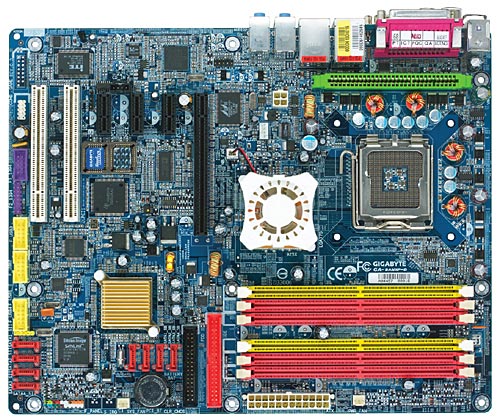
Gigabyte provides 6 DIMM slots, but the total memory and number of sides that can be used is the same as the other boards in the roundup. To populate all 6 slots, 4 of the DDR2 DIMMs need to be single-sided. The 6 slots are useful in that you can at least use your single-sided memory to reach 4GB, but the amount of memory and maximum number of banks are the same as the other designs. Layout of the Gigabyte generally works well, and we do like the pull release for the PCIe x16 slot. All you have to do is mount and unmount a 2-slot nVidia 6800 Ultra to learn to hate the push lever design.
There are a couple of things that could definitely be improved on the layout of the Gigabyte, however. The IDE and floppy connectors are at the end of the PCIe video slot, a terrible location. What makes it worse is a long card, like the nVidia 6 series, falls right between the floppy and IDE connector, making cable routing to mount and unmount the video card a real pain with a long video card. The 24-pin power connector is fine at the upper right edge, but the 4-pin 12 volt sits almost in the center left of the board. That makes snaking the 12V cable around the CPU in most case designs extremely difficult. It was easier to hang the cable over the CPU in our mid-tower case where it got caught in the powerful Intel CPU fan a couple of times. You can work around these two issues, but they can definitely be improved upon. Otherwise, the layout works fine in most cases.
Gigabyte 8ANXP-D: Overclocking and Stress Testing
FSB Overclocking Results
| Front Side Bus Overclocking Testbed | ||
| Processor: | Pentium 4 Prescott LGA 775 2.8GHz |
|
| CPU Voltage: | 1.3875V (default) | |
| Cooling: | Thermaltake Jungle 502 | |
| Power Supply: | HiPro 470W | |
| Maximum OC: | 255FSB (+28%) | |
The only way to overclock an Intel CPU is to increase the FSB. When we first tested the Gigabyte, the overclock limit was less than 10%, 218 to be precise. With no adjustment for PCIe frequency, it appeared Gigabyte was fixing the PCIe bus, but they did have PCIe word overclocks like "PCIe Turbo". We went through several BIOS revisions to finally reach where Gigabyte is today, reaching 255 with the ATI X800 XT. However, the nVidia 6800 Ultra on the Gigabyte is still pretty mediocre at a maximum overclock of 228.
These results indicate Gigabyte is probably using a different approach to getting around the 10% OC issue. That also means that we may see even more improvement in the 8ANXP-D overclocking performance in the future.
Memory Stress Test Results:
The memory stress test measures the ability of the Gigabyte 8ANXP-D to operate at its officially supported memory frequency (533MHz DDR2), at the best performing memory timings that Crucial/Micron PC2-4300U will support. Memory stress testing was conducted by running DDR2 at 533MHz (stock 3:4 ratio) with 2 DIMM slots operating in Dual-Channel mode.| Stable DDR533 Timings - 2 DIMMs (2/4 DIMMs - 1 Dual-Channel Bank) |
|
| Clock Speed: | 266MHz |
| Timing Mode: | 3:4 (200:266 - Default) |
| CAS Latency: | 3.0 |
| Bank Interleave: | Auto |
| RAS to CAS Delay: | 3 |
| RAS Precharge: | 3 |
| Cycle Time (tRAS): | 10* |
| Command Rate: | N/A |
Like the other 925X motherboards in this roundup, the Gigabyte was completely stable with 2 DDR2 modules at the best performing settings of 3-3-3-10 at default speed and 1.8V default voltage.
Filling all four available memory slots is more strenuous on the memory sub-system than testing 2 DDR2 modules on a motherboard.
| Stable DDR533 Timings - 4 DIMMs (4/4 DIMMs - 2 Dual-Channel Banks) |
|
| Clock Speed: | 266MHz |
| Timing Mode: | 3:4 (200:266 - Default) |
| CAS Latency: | 4.0 |
| Bank Interleave: | Auto |
| RAS to CAS Delay: | 4 |
| RAS Precharge: | 3 |
| Cycle Time (tRAS): | 10 |
| Command Rate: | N/A |
The Gigabyte board required 4-4-3 timings for complete stability at default voltage with 4 DIMMs. This is slightly slower than the best boards in the roundup with 4 DIMMs, but it is very close to the best 4-3-3 settings. As was said in the Foxconn review, the next Gigabyte 8ANXP-D that we test might well do 4-3-3 timings with 4 DIMMs, as it could just as well be explained as normal production variation in 925X chipsets or Gigabyte motherboards. This small difference in memory timings is not really that significant.
Standard Performance Test Configuration
If you are interested in more information comparing the LGA 775 Prescott, Athlon 64, Athlon 64 FX, P4, and P4EE, please see our in-depth comparisons in the recent reviews:Intel's 925X & LGA-775: Are Prescott 3.6 and PCI Express Graphics any Faster?
Intel 925X/915: Chipset Performance & DDR2
Socket 939 Chipsets: Motherboard Performance & PCI/AGP Locks
AMD Athlon 64 3800+ and FX-53: The First 939 CPUs
The Athlon 64 FX-53: AMD's Next Enthusiast Part
Intel's Pentium 4 E: Prescott Arrives with Luggage
Athlon64 3400+: Part 2
AMD's Athlon 64 3400+: Death of the FX-51
Athlon64 3000+: 64-bit at Half the Price
| Performance Test Configuration | |
| Processor(s): | Intel 560 (3.6GHz) Socket 775 AMD FX53 (2.4GHz) Socket 939 |
| RAM: | 2 x 512MB Crucial/Micron DDR2 533 2 x 512MB OCZ PC3200 Platinum Rev.2 (Samsung 2-2-2-5) |
| Hard Drive(s): | 2 x 250GB Maxtor MaXLine III (16MB Cache) in SATA RAID Seagate 120GB 7200RPM SATA (8Mb buffer) |
| Video AGP & IDE Bus Master Drivers: | Intel Chipset Driver 6.0.0.1014 Intel Application Accelerator 4.0.0.6211 NVIDIA nForce version 4.24 |
| Video Card(s): | nVidia GeForce 6800 Ultra PCIe nVidia GeForce 6800 Ultra AGP 8X |
| Video Drivers: | nVidia 61.77 Graphics Drivers |
| Operating System(s): | Windows XP Professional SP1 |
| Power Supply: | HiPro 470W (Intel) OCZ Power Stream 520W Enermax 465W |
| Motherboards: | Abit AA8 (925X) Asus P5AD2 Premium (925X) DFI LANParty 925X-T2 (925X) Foxconn 925X-A01 (925X) Gigabyte 8ANXP-D (925X) Intel 925XCV (Intel 925X) Socket 775 Intel 915GUX (Intel 915G) Socket 775 MSI K8N Neo2 (nForce3-250 Ultra) Socket 939 |
925X/915 tests used either Crucial PC2-4300U or Micron PC2-4300U memory modules. These are basically the same memory. DDR2 was run at 3-3-3-10 timings, at default voltage, which are faster timings than the SPD 4-4-4-12. Tests of the FX53 used OCZ PC3200 Platinum Rev.2, which is based on Samsung memory chips, at 2-2-2-5 memory timings at JEDEC standard 2.6V.
The nVidia 6800 Ultra was used for all 925X/915 benchmarking, and the AGP 8X 6800 Ultra was used for FX53 tests. This allows for better comparison of all results, since the 9800 PRO is not available in a PCIe configuration. All performance tests were run with AGP Aperture set to 128MB with Fast Write enabled. Resolution in all benchmarks is 1024x768x32 unless otherwise noted.
Workstation Benchmarks Not Included
Workstation benchmark results with SPECviewperf 7.1.1 have been extremely variable on the 925X/915 chipsets. Results are so inconsistent, with up to 50% variation from one board to another using the same configuration, that Workstation benchmarks will be excluded from 925X/915 reviews until we can discover and fix the inconsistency or we can establish a new suite of Workstation benchmarks.Additions to Performance Tests
AutoGK (Auto Gordian Knot) has been selected as the new standard for Encoding benchmarking. This benchmark is partially based on the DVD2AVI engine and we use DivX 5.1.1 as the encoding codec. Test results are complied with a 2-pass encoding using "Sum of All Fear", Chapter 9 as the video source.Game Benchmarks
We have added four new Gaming tests to our standard suite of gaming benchmarks. Far Cry is a popular Direct X 9.0b game, which is run with a custom benchmark called airstrip. We have also added UT2004 with a custom benchmark called UTBench, although we are continuing to run UT2003 standard benchmarks to allow comparison to past tests. Return to Castle Wolfenstein - Enemy Within is a recent OpenGL game based on the Quake engine. We are finding that it is an excellent benchmark for measuring system performance, and it will likely replace Quake3 as our standard OpenGL benchmark down the road. We have also included the Final Fantasy XI benchmark, which is DX9.Other standard game benchmarks include Halo, Microsoft's Direct X 9.0b game; Splinter Cell, a DX9 game; X2 Benchmark, a DX 8.1 game, which includes Transform and Lighting effects; the DX9 Aquamark 3, and Unreal Tournament 2003. The DX 8.1 Comanche 4 benchmark is also used with the 4X anti-aliasing setting a 1280x1024 resolution to differentiate system performance better using the nVidia 6800 Ultra.
General Performance and Encoding
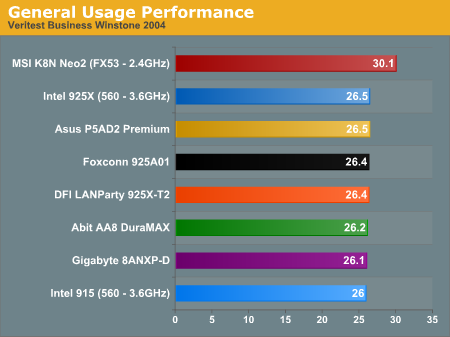
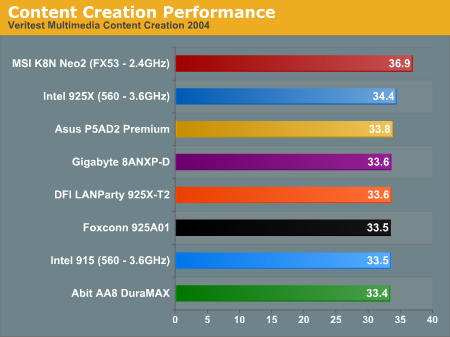
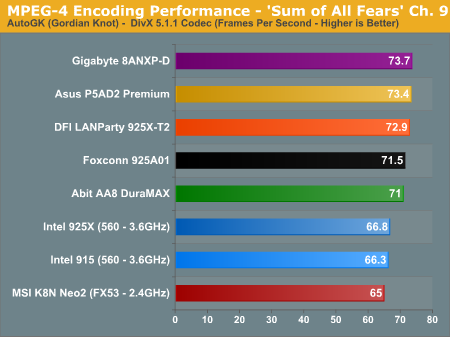
With all motherboards based on the same Intel 925X chipset and tested with the same CPU, it is not a surprise that the test results for Multimedia Content Creation Winstone and Business Winstone are tightly clustered. You may be more interested in comparisons to the Intel 915 chipset board, which is just a bit slower, and the Athlon 64 FX53, which dominates these two general performance areas.
The performance of the LGA 775 925X boards in the new AutoGK 2-pass Media Encoding benchmark was pretty much what was expected. Intel has dominated media encoding in the past, but results are now close comparing the top 925X boards to a top 939 Athlon 64 board. With these top-line 925X boards combined with the top 3.6 Prescott CPU and DDR2 running at 3-3-3 instead of the slower 4-4-4 timings, Intel retains a small lead in Media encoding.
We expected Intel to retain their lead in media encoding due to our logical choice of DivX 5.1.1 as the encoding codec. This codec fully exploits the SSE3 features of the Intel chipset and generally favors the Intel processors. The DVD2AVI engine at the heart of AutoGK, on the other hand, generally favors AMD processors. It appears that you can really show whatever you wish in encoding these days, depending on the Encoding program and codec used. Anand did extensive research on media encoding and chose the new AutoGK/DivX 5.1.1. as our new standard due to the fair, balanced and respected results obtained with this combination.
DirectX 9 Gaming Performance
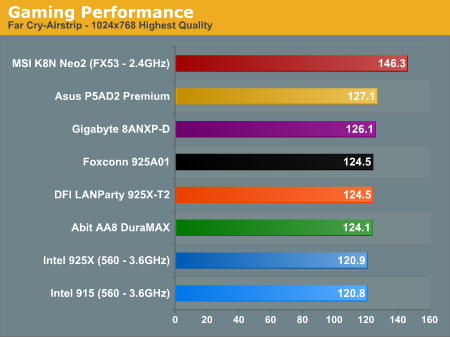
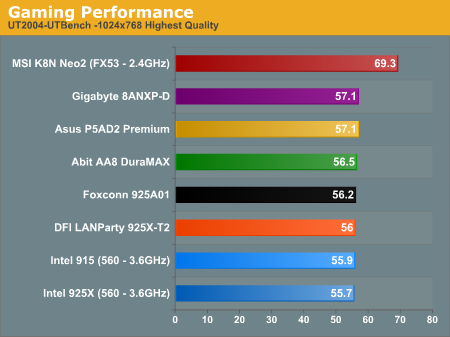


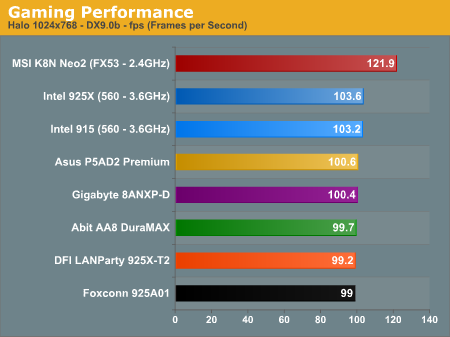
After the close scores in Winstones, we really did not expect much variation in game benchmarks. As we have said before, expectations can lead to wrong conclusions. As you look across the DirectX 9 gaming benchmarks, the Asus P5AD2 and Gigabyte 8ANXP-D are always number 1 and number 2. They switch positions in a few benches, but across the board, it is generally Asus, Gigabyte, then everyone else. This is particularly intriguing, since both the Asus and Gigabyte boards are the two premium boards in the roundup.
The other three boards seem to shift positions, but none of others really stand out like the Asus and Gigabyte in these benchmarks of the most recent DX9 games. None of the 925X boards can really keep up with the Athlon 64 FX53, but we already knew that from results of the Socket 939 Roundup.
DirectX 8 & Open GL Gaming Performance
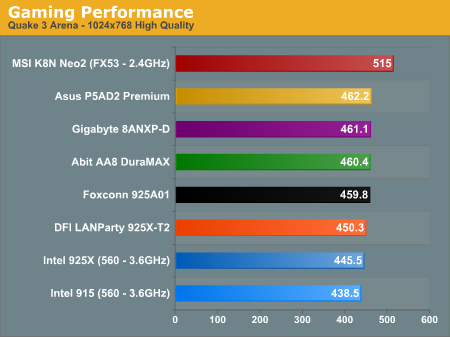

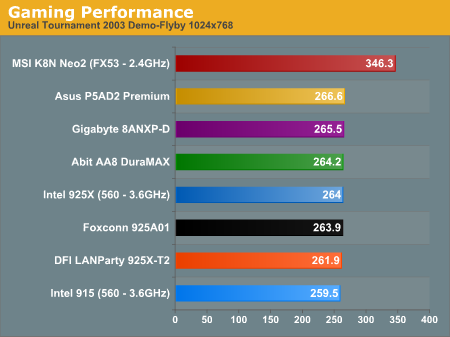

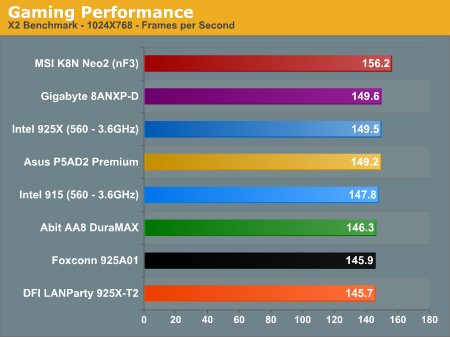
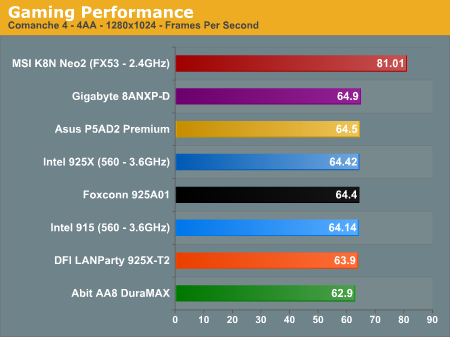
The same pattern of Asus and Gigabyte topping the gaming charts is seen in DirectX 8 and Open GL games, but in these benchmarks, they are joined by Abit. These three motherboards top the benchmarks for all 6 DX8/OpenGL games. We still see Gigabyte and Asus in the top few positions of the boards tested in all the benchmarks.
The biggest surprise in the roundup is the rather average performance of the DFI LANParty at stock speeds. Perhaps this has to do with the tested board being a very early production sample. As you can see, test results of the DFI generally top Intel, but they are toward the bottom of results compared with these five boards. We have seen reports of incredible overclocking with phase-change cooling on the DFI, and we wonder if the slightly more relaxed results at stock speeds may be part of what will likely end up as one of the better overclocking boards using the 925X/915 chipset. We will withhold final judgment until we get a chance to evaluate a release production board with all the final tweaks and a finished BIOS.
Final Words
For the last seven weeks since the 925X/915 chipsets were released, AnandTech has felt like an R&D lab for motherboard manufacturers. It seems as if every day brought new revelations and some new BIOS to fix some overclocking or performance issue. If we look at where performance started and where it is today, we would have to conclude that the improvements are remarkable. This is particularly true in the overclocking arena, where real progress has been made in meeting the challenges of the new Intel design.But if, as the old saying goes, "confession is good for the soul", then we have to confess that the whole process has been a lot harder than it needed to be. All of this work was only necessary because Intel decided, after a couple of years of the remarkable overclocking abilities of the Northwood processor, that it was giving away too much performance for free. So, in designing the 925X/915, Intel made any significant overclocking as difficult as possible. We suspect Intel's plan was that significant overclocking of Intel chips would now be a thing of the past.
It turns out that the motherboard manufacturers have been up to the task of finding ways around these issues, but what we are left with, by and large, are band-aids on a fester. The issue isn't really fixed because we are certain that Intel does not see the constraints to overclocking as a real issue. What is most remarkable is that these new challenges are thrown at the Enthusiast community just at the time when Intel is losing significant ground to AMD in the performance arena. We have to wonder what Intel is thinking these days in trying to take away the one performance advantage they still held over Athlon 64, and that is the remarkable overclocking ability of the Pentium 4.
The five 925X boards in this roundup have all finally found some method of achieving reasonable success in reaching performance levels that Intel never intended you to reach. However, they are far from fixed and there is still much room for improvement - with one notable exception. The overclocking field for 925X right now seems to be clearly the Asus P5AD2 Premium, followed by a wide margin by everything else. We don't know how Asus did it, but for the past month, every other manufacturer has also been trying to figure it out, and they haven't completely figured it out either. So, Asus wins the Creative Engineering 101 award in a very spirited race. It is the only motherboard in the running that managed a 280 FSB with a top-line PCIe video card and a SATA hard drive on air cooling, and number 2 is at 265 after many, many BIOS revisions.
However, it would also be a mistake to look only at overclocking ability in evaluating these five top 925X motherboards because it totally dismisses the important performance differences that we found in these five at stock speed. Fortunately, this is one situation where the winner in the overclocking wars is also the top performer in stock speed benchmarks. In benchmark after benchmark, Asus and Gigabyte were the top 2 performers. That combined with the Asus domination of the 925X overclocking gives that rare clear winner of the 925X roundup.
 |
Based on top performance at stock speeds, the wonderful implementation of Intel 925X/ICH6R features, the excellent enhancements to those features such as Stack Cool, Dolby Digital Live encoding, WiFi G networking, dual PCI Express LAN, high-speed 1394b firewire, and the best overclocking abilities of any 925X motherboard, we are pleased to award the AnandTech Gold Editors Choice to the Asus P5AD2 Premium. The P5AD2 hardly qualifies as cheap, but it does deliver excellent value with a standout range of features, enhancements, and performance. |
All four of the remaining boards in our roundup excel in one or more areas. The Gigabyte 9ANXP-D is essentially the equal of the Asus in performance at stock speed, and it is second only to the Asus P5AD2 in features. Both the Abit and DFI are excellent in overclocking, and both boards deliver a range of BIOS adjustments that will satisfy any Enthusiast. The Abit and Foxconn boards both deliver excellent value for the features that they deliver and both are cheaper than the other boards in the roundup.
In the end, the other four boards in our roundup are far too close in performance, value, overclocking abilities, or features compared to price to select a Silver or Bronze winner. There is just too little to distinguish them from the other excellent boards in the roundup, though the Gigabyte, Abit, and DFI are clearly a step ahead.
The question that remains is the value that these 925X boards deliver relative to what the competition offers. If you are buying a whole new system, then perhaps there is value here. If we had confidence that the new technologies, which are heaped on the 925X/915/LGA 775, were lasting, then that could sway a decision to one of the new systems. If we had confidence that the bus and DDR2 speeds would be viable for more than a couple of months, then a new 925X/915 might make sense. Unfortunately, we don't have confidence in any of these compelling reasons to buy a new 925X/915 system at this point.
What we can say is that the features delivered by the 925X/915 are truly excellent, and some of the new technologies, like PCI Express and High Definition audio, will either become the norm or heavily influence directions in the computer industry. We can also say with confidence that if you are looking for a new Intel system, you won't find a better motherboard than the Asus P5AD2 Premium to be the heart of your new LGA 775 system. The Asus is expensive, but it does deliver value. If the price is too much for your budget, then any of the other four boards can be recommended as decent alternatives.







